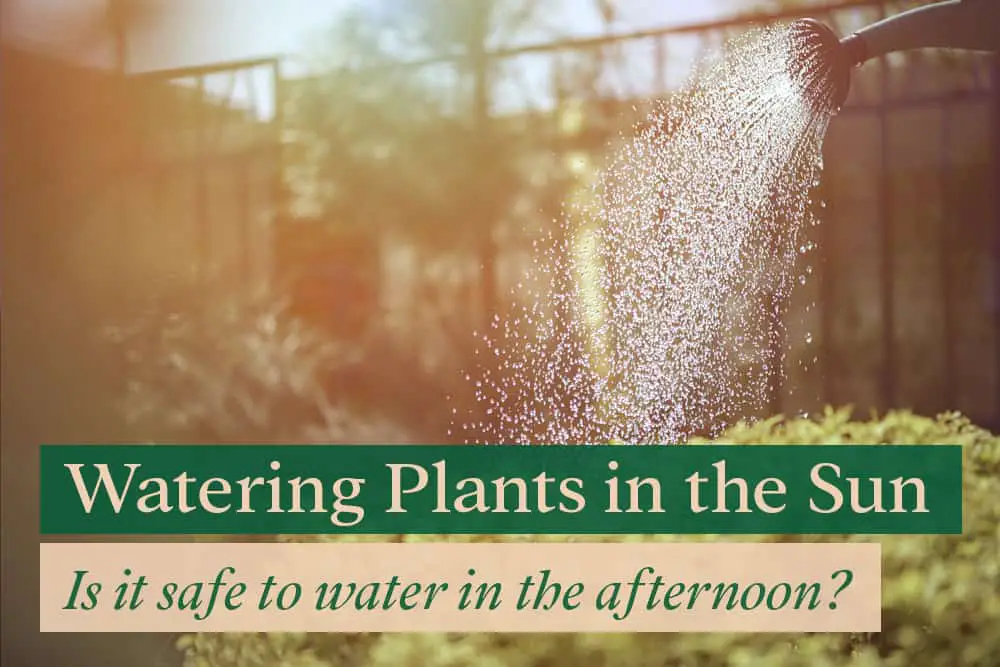
Have you ever wondered if it’s safe to water your plants in the midday sun? Do water droplets magnify the sun’s rays enough to scorch leaves?
Generally, watering plants in the hottest part of the day will not burn their leaves and can even help them avoid excessive water loss through transpiration. However, plants will not receive enough water as most of it evaporates before reaching the roots.
In this article, I’ll share the best time to water your plants and how to stay on top of watering during a heatwave.
Let’s get started!
Disclaimer: As an Amazon Associate I earn from qualifying purchases.
When is the best time of day to water your garden and plants?
Early morning (5:00 to 9:00 am) is the best time to water your plants because this allows the plant roots enough time to absorb the water before it evaporates in the hot afternoon sun.
If you have a busy morning schedule, I recommend installing an automatic sprinkler with the timer. This has saved me time, and my plants seem happier too!
It is also safe to water plants in the evening, between 4:00 pm to 6:00 pm. This leaves time for roots to absorb the water before nightfall.
Be mindful not to wet the leaves and overwater your plants as they lead to rot, fungal growth, and insects.

When should you water plants on a hot day?
In general, plants grow best in moderate temperature between 70°F to 80°F (21°C to 27°C) and humidity levels above 40%.
However, plants will struggle to absorb water and nutrients when the soil temperature exceeds the optimum threshold, and the humidity level is too low. This can lead to plant stress and death.
If you live in a hot and dry climate or in the midst of a heatwave, it’s important to water during the midday. This helps reduce soil temperature and increase humidity due to evaporative cooling.
While not the most efficient use of water, there are moments when it’s appropriate to use water to maintain a healthy garden.
Also Read: Is it Safe to Use Hot Water for Plants?
How often to water during hot, dry weather
In the hot and dry weather, consider watering your plants more often to keep them alive.
Outdoor potted plants kept in smaller terracotta pots and well-draining soil will dry up much faster than in-ground plants. You may need to water them daily.
As for plants in the ground, you might need to water them three times a week.
Make sure to soak the soil while aiming the water at the root zone of your plants. Light, sporadic sprinklings of water will quickly evaporate and not do much for the plants.
Also Read: How Many Days Can Plants Survive Without Water?
Tips for watering in hot weather
During hot weather, here are some tips I’ve found that can help plants to thrive and save water:
1. Top Dress Your Soil with Mulch

In case you are wondering, mulch is a layer of natural material, usually placed over the soil and around plants to prevent weeds from growing.
However, mulch also has a spongy characteristic that helps it absorb and retain water for a longer period of time.
Moreover, layering mulch on top of the soil will protect it from direct heat and reduce moisture loss through evaporation.
I am using hardwood bark mulch on both my potted and in-ground plants. Not only is it aesthetically pleasing, but hardwood bark mulch also helps amend the soil and offers rich nutrients.
Alternatively, you can use shredded leaves and pine needles for an affordable choice of mulch.
2. Provide Shades to Your Plants
Providing shade will protect your plants from the full sun and help cool the soil, reducing the rate of evaporation.
You can easily provide shade for your potted houseplants by moving them around to the shady part of your home.
However, for your plants outside, you may need to install sunshade UV-resistant netting over the plants. This netting blocks approximately 50%-70% of sunlight while still allowing good airflow.
3. Use Humidifier for Indoor Plants
Dry air contains less moisture, which increases the rate of water loss from plants through transpiration.
You should maintain humidity levels around your houseplants at around 40% to 60%. Below that, plants can suffer dehydration, stress, and even death.
The use of a humidifier can help increase the humidity level in your home, which will result in less water loss and ultimately happier plants.
The humidifier should run for at least 4-5 hours per day in the morning until midday. Running it too late into the afternoon risks leaving too much moisture in the air overnight, increasing your risk of developing mold or fungus.
4. Install Sprinklers

You can use a sprinkler to help your plants during an intense heatwave.
Most of the water from a sprinkler will be lost through evaporation during a very hot sunny day. It may seem ineffective, but this helps extract heat from the soil and improve moisture in the air.
You can turn your sprinkler for at least 30 minutes during midday or when the temperature is over 90°F (32°C).
